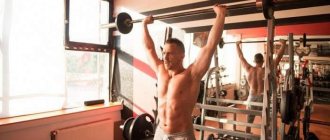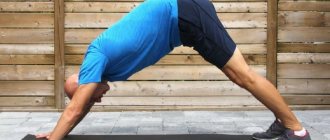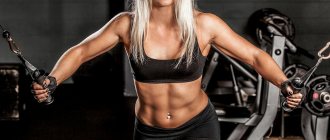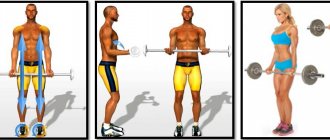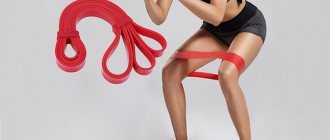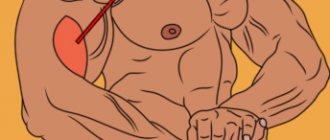In order to make training more effective and achieve the desired result, pushing through the so-called “growth plateau”, improve strength indicators, accelerate muscle growth and other sports achievements, there are various training methods. One of the effective methods is considered to be increasing the intensity of the load on the athletes’ muscles and involves performing supersets. This method is not suitable for everyone. Most often, it is used by experienced athletes, but this training method is also relevant for those whose stay in gyms is aimed at losing weight.
What are supersets and trisets in bodybuilding and what are they used for?
A superset is a complex, or rather an approach, of two exercises. They target antagonistic muscles, such as the triceps and biceps, or synergistic muscles, where the exercise is performed on the same muscle group (the same or different parts) without rest between exercises.
When composing a superset combination for synergists, the following should be taken into account: the first exercise should be basic, involve the main part of the muscle, that is, be heavier, and the second exercise should be less complex, rather isolating, which gives a pumping effect.
A superset on synergistic muscles is often called a combined set. Combining two exercises is not the limit, and in order to maximally load the body and achieve high training intensity, there is another option for combining exercises - triset . As you probably guessed, this option involves performing three exercises in a row at once. The principle of performing this complex is identical to the superset. But this method gives a more powerful impetus in overcoming stagnation in strength and growth. This option is only suitable for trained athletes.
There is also a “giant set”, which combines four or five exercises for one muscle group. As already mentioned, in any of these three options, sets of several exercises are performed without rest and this is very important! But in the break between sets, the rest increases and lasts two or even three minutes.
In bodybuilding, training using this technique is a very effective solution, since it has a much stronger effect on the muscles being trained. For example, in a triset you can combine exercises that have different effects on the target muscles, such as stretching, neutral, and contracting movements.
You can “play” with the number of repetitions, for example, conduct a workout with “ladder” exercises, in which 6-8 repetitions are used in the first exercise, 12 in the second, and from 15 to 25 in the third! Accordingly, in this embodiment, the working weight in each subsequent exercise decreases.
By the way, bodybuilders often experiment with different grips and speed of performing the exercise, as well as with a pause at a certain point in the amplitude.
Combinations of antagonist muscles in training for greater efficiency:
- Biceps and triceps training . It is important to perform supersets on the pectoral and back muscles along with training, or train the arm muscles on deltoids day.
- Chest and back muscle training . On this day you can add supersets for the arm muscles.
- Training the leg muscles (quadriceps, biceps femoris, buttocks and calves).
- Supersets are also relevant for training the forearm muscles, which are performed on arm day.
In bodybuilding, the actual effect of supersets on muscles is pumping, so using this training method, the athlete must increase the number of repetitions and reduce the working weight.
After completing any of the sets, during rest, the working muscles need to be properly stretched.
The number of supersets varies depending on the athlete's training. Typically, the number of supersets in one workout is from three to four.
Read more about antagonist and synergist muscles →
How to use trisets on antagonist muscles?
To make it clear, let's look at an example. For example, let's take the back and chest. Here you can do 2 back exercises + 1 chest exercise, or 2 chest exercises + 1 back exercise. Let's say we do 2 on the back + 1 on the chest. Let's take the following exercises: Pull-ups on the bar + Bent-over barbell press at an angle of 25 degrees upwards. So, let's go...
We perform “pull-ups on the bar” for a pre-planned number of times. After this (without rest), we proceed to the “bench press at an angle of 25 degrees upward” ... perform it with a certain weight, for a pre-planned number of times. After this (again, without rest), we proceed to the third exercise... the “bent over barbell row”... we perform it with a certain weight, for a pre-planned number of times. All! The approach is over, and now you can allow yourself to rest.
Examples:
Trisets for pectoral muscles + back muscles:
- bench press lying on a horizontal bench + barbell row in an incline position + dumbbell flyes lying at an angle of 25 degrees upward
- pull-ups on the horizontal bar with a wide grip + bench press at an angle of 25 degrees upward + rows on a horizontal block to the waist
Trisets for triceps + biceps:
- close grip bench press + standing barbell curl + French barbell bench press
- standing dumbbell biceps curl with supination + triceps push-ups + dumbbell hammer
Trisets for quadriceps + hamstrings (buttocks are also involved):
- barbell squats + lying leg curls + lunges
- deadlift on straight legs with a barbell + seated leg extension + lying leg curl
Trisets for abdominal muscles + back extensors:
- hanging leg raises on the horizontal bar + hyperextension (emphasis on the back) + bicycle (abs exercise)
- bending with a barbell on the back + lying crunches + hyperextension (emphasis on the back)
Trisets for front delts + rear delts:
- standing military barbell press + bent over dumbbell swings + front dumbbell raise
- Bent-over barbell rows for rear delts + front dumbbell raises + bent-over dumbbell swings
Trisets for pectoral muscles + rear deltoids:
- bench press lying on a horizontal bench + dumbbell swings + dumbbell flyes lying at an angle of 25 degrees upward
- bent-over barbell row for rear delts + lying dumbbell flyes + bent-over dumbbell swings
Trisets for back muscles + front deltoids:
- Pull-ups on the horizontal bar with a wide grip + lifting dumbbells in front of you + one-arm dumbbell row in an incline position
- standing military barbell press + bent-over barbell row + front dumbbell raise
Rest between sets is selected individually (from 30 seconds to 2 minutes). If this is drying and you need more intensity, then rest can be 30 - 40 seconds. If this is a set of muscle mass and you need to take as much weight as possible, then 60 - 120 seconds. The number of repetitions in exercises is selected individually. Do 8 to 20 repetitions of each exercise. For example, you can do this:
- Exercise No. 1 – 10 reps + Exercise No. 2 – 10 reps
- Exercise No. 1 – 8 reps + Exercise No. 2 – 15 reps
- and so on …
Advantages and disadvantages of supersets
- A highly effective set of two exercises that increases the intensity of the training and the load on the target muscles compared to a single approach.
- Promotes deep muscle development, involving more muscle fibers.
- Effectively pumps the target muscles and increases muscle endurance.
- Reduces training time without affecting efficiency and strength indicators.
- It creates a shock for the body, as a result of which the athlete leaves the comfortable conditions, which allows the results to move forward.
- The method allows you to increase strength, endurance, and even promote weight loss.
Among the disadvantages, it can be noted that this technique is not suitable for all athletes. It is not recommended for beginners to perform super- and trisets, since unprepared muscles will not be able to withstand such a load, this will either lead to injury or overwork and severe trauma to the fibers.
How muscles work and grow
Contrary to clearly established scientific facts, many coaches and athletes continue to make the same mistakes. In order not to repeat them, let's look at the basic principles of how muscles grow and what specific work muscle fibers do.
Principle one
Bundles of muscles attached to one tendon work the same way, regardless of the nature of the load received. The total muscle force is the total force of all these bundles. Therefore, it is impossible to involve one bundle into more active work, isolating it from another.
Principle two
Muscle fibers increase in size evenly along their entire length. You cannot develop only one part of a muscle and leave the other part unaffected or affected to a lesser extent. It is genetics that determines the difference in the development of different parts of muscle bundles, and the first criterion here is the length of the tendon that fixes them to the bone.
Principle three
The opinion that performing the same exercise leads to a muscle getting used to it, ceasing to develop it, is a misconception. If you maintain an adequate load and increase it correctly, this will not happen, even if you endlessly perform the same work from a mechanical point of view.
That is, to maintain and improve results, your first priority should not be to search for alternative exercises, but to change the rhythm, number of repetitions, working weights, and so on.
Based on the above, we will consider training the biceps and triceps, drawing the appropriate conclusions.
Circular superset for the buttocks area
Circular training for the buttocks and thighs is carried out no more than once a week, since it is necessary to allow the muscle tissue to recover from aggressive effects on them and complete the biochemical process of synthesizing new cells. Mandatory conditions for a superset are the dynamics of movements, the absence of inertia in them and adherence to exercise technique. The training is carried out without rest between exercises. A short break to restore breathing is possible between blocks, the number of which they try to increase to 4-5.
Exercise No. 1 – Squat with a side step
Starting position: standing, body straight. Taking a step to the side, squat until the thigh reaches a position parallel to the floor. You should try to keep your back as straight as possible, but a slight forward bend is allowed without bending the spine. Hands are clasped in front of you to maintain body balance.
It is important to follow the correct squatting technique and not to focus the movement on one hip. Having taken a step and leaving your buttocks down, keep your body vertical
Watch the position of your knees. When they are pushed inward, the effort directed at tensing the gluteal muscles decreases, which interferes with the effectiveness of the exercise. The exercise is performed 20-25 times in one direction and the same amount in the other, while combining a high tempo and the correct training technique.
Exercise No. 2 – Lunge-Curtsey
To perform the exercise, take a step back so that you can sit down in a position that simulates a curtsey. Keeping the body tilted forward, squat so that the leg going down does not touch the floor with the knee. The hands are clasped in front for balance. The correct technique is to perform the movement with emphasis on the gluteal area
To push, it is important not to shift the emphasis to the quadriceps of the limb that goes down, but to use the force of the front thigh. A wide range of stretching between the body and the knee will allow maximum load on the gluteal muscles
For experienced athletes, an option is possible when the movement is performed with alternating changes of legs. However, it is difficult for beginners to maintain balance and follow the movement technique, so they first perform 20-25 lunges on one leg, then change position and repeat the movement for the second.
Exercise No. 3 – Bend forward on straight legs
The exercise is aimed at the upper zone of the buttocks. Starting position: feet shoulder-width apart, but not too wide, resting on the heels, hands clasped near the chest. Tilt the body so that the back remains straight and the hip muscles receive maximum stretch. The movement is performed by stretching the muscles of the gluteal area. You can diversify the exercise by using a barbell or bodybar, holding them on your shoulders. The forward bend is performed as low as the amplitude of stretching the buttocks allows, but without bending the back - this removes the effort from the area being worked. The number of repetitions is 20-50 times. This exercise is necessary to obtain a pumping effect, so the number of bends should be as large as possible until a characteristic burning sensation appears in the area.
Exercise No. 4 – Leg swings
The exercise improves the inner and outer thighs. Starting position: lying on your back, hands clasped behind your head, legs raised up and knees bent, toes pointing down. Simultaneously lift the legs vertically upward, then make a sharp swing with the legs to the sides, fold them back together vertically and lower them to the starting position. Execution technique - when lifting up, the knees should be straightened and tense; weakening the muscle tension worsens the result. The number of repetitions is 20-30 times. At the same time, the raised upper part of the body in constant tension will ensure the development of the abs.
Shoulder workout with dumbbells
This scheme for performing delt exercises with dumbbells is designed for 400 repetitions in the total of all exercises. We recommend that you look at our other shoulder workouts for mass and relief.
Starting with the rear delts and moving from there, you should perform 12 sets of dumbbells—with plenty of drop sets. The last exercise is quite exotic - it is a shoulder press in a hack squat machine. But if you are working out at home, then you can replace it with a parallel grip dumbbell press.
There is no need to try to take the maximum possible working weight. You just need to keep the intensity very high with proper technique, taking small breaks, and also maintaining volume. Try to do as many reps as possible with minimal rest between sets.
The entire workout should not take more than 30-45 minutes and you will force all the deltoid muscle bundles to increase in volume.
Superset No. 3 Lying dumbbell flyes + wide-grip bent-over rows[edit | edit code]
Arnold had heard well about a common injury - rupture of the pectoral muscle ligament when it is overstretched. In the interests of safety, he never abused the width of the amplitude when performing such an exercise as lying down with dumbbells. While others tried to lower the dumbbells lower and thereby stretch the pecs more, Arnold limited the movement to the level of the pectoral muscles themselves.
A typical sign of the time was the clanging of dumbbells when they hit each other above the chest, but Arnold was skilled in anatomy and knew that the vertical position of the arms meant relaxation of the pecs. The weight of the dumbbells is taken by the arm bones (humerus and ulna), which form strong straight supports when the elbow joints are closed. To maintain tension in the pectoral muscles, he left his arms slightly apart in the final upper position of the exercise. The "pyramid" for both exercises included 15-12-10-10-10 repetitions.
SUPER TIP
:To enhance the impact of the exercise, keep your body strictly parallel to the floor
